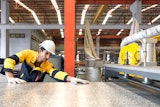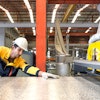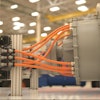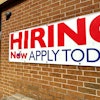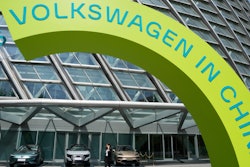Compressed air is your most expensive utility. This fact has been documented time and time again. It takes 7-8 hp of electricity to produce 1 hp in an airtool. Yet this high energy cost quite often is overlooked. Here are some questions you should ask yourself:
- Do you know what your compressed air costs are?
- Do you know how much compressed air is really required for your plant?
- Do you select compressed air equipment with energy costs in mind?
- Do you monitor the use of compressed air like your other utilities?
Here is the information you need to answer these questions, save energy, and improve your compressed air system operation.
Why Evaluate Energy Costs?
Depending on plant location and local power costs, the annual cost of electrical power can be equal to -- or as much as two times greater than -- the initial cost of the air compressor. Over a 10-year operating period, a 100 hp compressed air system that you bought for $40,000 will accumulate up to $800,000 in electrical power costs. Following a few simple steps can significantly reduce energy costs as much as 35%.
Identifying the Electrical Cost of Compressed Air
To judge the magnitude of the opportunities that exist to save electrical power costs in your compressed air system, it is important to identify the electrical cost of compressed air. Consider the following:
Direct cost of pressure: Every 10 psig increase of pressure in a plant system requires about 5% more power to produce. For example: A 520 cfm compressor, delivering air at 110 psig, requires about 100 hp. However, at 100 psig, only 95 hp is required. Potential power cost savings (at 10 cents per kWh; 8,760 hours) is $7,025 per year.
Indirect cost of pressure: System pressure affects air consumption on the use or demand side. The air system will automatically use more air at higher pressures. If there is no resulting increase in productivity, air is wasted. Increased air consumption caused by higher than needed pressure is called artificial demand.
An unregulated system using 520 cfm at 110 psig system pressure will consume only 400 cfm at 80 psig. The potential power cost savings (520 cfm - 400 cfm = 120 cfm = 24 hp, at 10 cents/kWh; 8,760 hr) is $16,864/year.
Also remember that the leakage rate is significantly reduced at lower pressures, and the cost of wasted air volume. Each cfm of air volume wasted can be translated into extra compressor hp and is an identifiable cost. If this waste is recovered, the result will be about $750/hp per year in lower energy costs.
Select the Most Efficient Control
The magnitude of the above is solely dependent on the ability of the compressor control to translate reduced air flow into lower electrical power consumption. The online-offline control (dual control) is superior to other controls in translating savings in air consumption into real power savings. Looking at our example of reducing air consumption from 520 cfm to 400 cfm (77%), the compressor operating on dual control requires 83% of full-load power. That is 12% less energy than when operated on modulation control. If the air consumption drops to 50%, the difference (dual vs modulation) in energy consumption is increased even further, to 24%.
Justifying a More Energy-Efficient Compressed Air System
Look beyond the purchase price: as noted earlier, the electrical power costs of a compressed air system impact the bottom line far more than initial price and maintenance. How can we evaluate the true impact each element of the compressed air system has on the electrical power costs?
The air compressor package has a very significant impact on overall operating power costs. Other pieces of equipment in a compressed air system support the air compressor; these also impact on power costs, both directly and indirectly. But the core of it all is the air compressor package. Energy wasted at the air compressor site can never be recovered.
What are the components of an energy-efficient air compressor?
- Compressor element (airend) -- performance can vary up to 20% depending on what airend size and style is used.
- Drive motor efficiency -- at the 100 hp size, there is a maximum efficiency difference of no more than 2% between EPAct and premium efficiencies. Referring to the previous example, a 100 hp compressor would save $1,500 annually.
- Compressor controls -- are an important part of the air compressor package, matching compressor supply to demand. As outlined previously, the right control type (dual control) is essential for efficient operation. Maximum savings of 45% are possible. Any reduction of air usage in a system accomplished by good demand-side management (adequate storage and flow controller) can be translated into real power cost savings by the control system, and none does this better than dual control.
System Master Controls
A microprocessor-integrated controller allows the system to maintain a stable system pressure and ensures that only needed compressor units are operating at their most efficient level.
User-friendly, PLC-based controllers can mix and match compressor supply to demand, including automatically shutting off units not needed, and bring on backup units as required.
Advanced controllers not only sequence and select units as required, but also ensure that no more than one unit in a multiple-unit installation will be operating at inefficient part load. All other units will be operating efficiently at full load.
Electrical power savings result from operating fewer compressors at a lower pressure than with conventionally controlled compressors.
Reduce Pressure Drop in System Components
When buying or replacing equipment, make sure it maintains low pressure drop over its entire service life. Also, ensure that filters and dryer are sized and maintained properly. The total pressure drop across all compressed air system components, including piping, should not exceed 15 psi.
Add to your savings with waste heat recovery, flow controller, and leak reduction. Waste heat recovered from compressors can be used effectively within a plant for space heating and/or process water heating. Considerable energy savings result in short payback periods.
Process heating: Heated water is available from units equipped with water-cooled oil coolers and aftercoolers. Generally, these units can effectively discharge the water at temperatures between 130°F and 160°F.
Space heating is essentially accomplished by ducting the heated cooling air from the compressor package to an area that requires heating. If ductwork is used, be careful not to exceed the manufacturer's maximum back-pressure allowance. When space heating is used in the winter, arrangements should be made in the ductwork to return some of the heated air to the compressor room in order to maintain a 60°F room temperature. This ensures that the air discharged is at comfortable levels.
Waste heat recovery is particularly effective when the primary air compressor package is an oil-cooled rotary screw type.
Estimating the real energy savings in dollars must include identifying the actual cost of the current source of energy (natural gas, electric, propane, etc.).
Use of Flow Controllers
Most compressed air systems operate at artificially high pressures to compensate for flow fluctuations, leaks, and downstream pressure drops caused by lack of "real" storage and improperly designed piping systems. Even if additional compressor capacity is available, the time delay caused by bringing the necessary compressor(s) online would cause unacceptable pressure drop.
Operating at these artificially high pressures requires up to 25% more compressor capacity than actually needed. This 25% in wasted operating cost can be eliminated by reduced leakage and elimination of artificial demand.
A flow controller separates the supply side (compressors, dryers, and filters) from the demand side (distribution system). It creates "real" storage within the receiver tank(s) by accumulating compressed air without delivering it downstream. The air pressure only increases upstream of the air receiver, while the flow controller delivers the needed flow downstream at a constant, lower system pressure. This reduces the actual flow demand by substantially reducing leakage and artificial demand.
Find and Reduce Leaks
Leaks are expensive. Statistics show that the average system wastes between 25-35% to leaks. Routine leak monitoring and repair are essential to control costs. Equip maintenance personnel with proper leak detection equipment, and train them in how to use it. Establish a routine for regular leak inspections. Involve both maintenance and production personnel.
